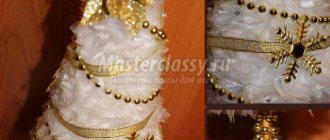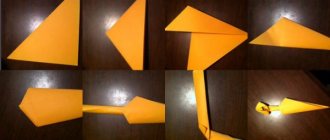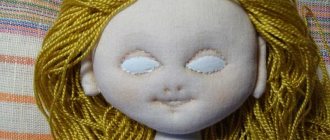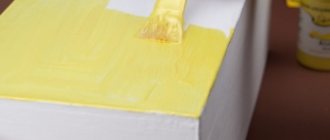Making products from twine is a newfangled trend in needlework. The material is used for both small and large crafts. Jute is used to weave stylish rugs and beautiful boxes - spectacular and inexpensive products that decorate the house, maintaining a rustic style and Provence. You can buy jute rugs or knit them yourself.
A cute little thing that is not difficult to make from jute with your own hands is a box.
You can store jewelry, memorabilia and trinkets that are simply dear to a woman’s heart in it.
Creative people are always interested in new directions, for example, various decorative elements, boxes, figurines, baskets and much more can be made from twine. Jewelry boxes made of jute and other small items are very popular.
A beautiful round box made of jute filigree technique will be a wonderful gift for family and friends.
To learn how to crochet a box, you need to read the detailed instructions for making it. With minimal cost and effort, the technology allows you to produce an original product.
The box can also serve as a decorative element for your own boudoir.
Jute is a magical material, you can make almost anything from it.
Crochet jute thread box
Materials:
- cardboard base in the shape of a cylinder;
- jute thread;
- wood beads;
- hook;
- sheets of cardboard;
- silicone glue.
The amount of material depends on what size you want to make the product.
A wicker jute box will help you and delight you for a long time.
Decorative details: box decor
Take three strands of the tourniquet. Glue the edges together. Make a loop from each thread so that one is 5 mm larger than the other. Small loops look nice. Secure the edges with glue over the ends and cut off the free edge.
Decorative elements made from rope
Glue the finished loops under the braid between the braiding joints. Leave the penultimate ones empty where the lid will open. Also glue decorative loops to the bottom corners on each side. They imitate the legs of a chest.
Glue half beads onto each loop to complete the picture.
Execution technique
First of all we make the bottom. You need to draw a pencil along the inside of the cylinder and cut out the resulting circle. You need to leave approximately 5 mm in reserve. We make cuts along the contour and glue the bottom for the workpiece. We put another circle on top of it and secure it with glue.
This box will decorate any home or become a pleasant gift for friends or colleagues.
The jute rope needs to be twisted into a spiral. Fixing it with glue, screw it on, completely filling the bottom area.
Wraps the side of the workpiece in the same way.
The work is done carefully so that there are no gaps in the cardboard.
Jute filigree is becoming very popular among needlewomen.
Using a hook, you need to knit chains of air loops. Its length is equal to the circumference of the cylinder. The lid is made in the same way as the bottom of the product. You can crochet it.
Interior items made using filigree technique from jute cord fit harmoniously into the interior and can become a beautiful and expensive gift.
We cast on 2 air loops, and in the 3rd - 12 columns, then the number of loops needs to be doubled. Third row - knit 36 loops. We continue to perform the next two rows with 36 loops each. This way you will get a knitted lid for the box. We stretch ropes from the front side and attach wooden beads to them. We tie the ends into bows.
Considering the availability of jute, the main material for such creativity, absolutely everyone can master the technique of jute filigree.
You can draw a drawing on paper and work from the drawing, or you can immediately lay out the drawing in a frame.
Weaving storage boxes
The preparations are over. It's time to start weaving. You will need a tourniquet, Dragon glue, and scissors. Weaving from the rope will go in one thread.
The first rows are the most difficult. Choose a place where the cut box will fit freely so you can twist it.
Glue the end of the rope to the corner inside the box. Bring the tourniquet out to the front side. Weave by going around the strips one at a time, as shown in the photo below.
Box weaving. Red dots show row 1, white dots show row 2.
If the thread comes from the front side of the guide in the first row, then in the second row the bundle should go inside the box. An odd number of cardboard guide strips ensures correct weaving. Press the tourniquet down after each turn. Do not tighten the harness too much, otherwise the distance between the box guides will be reduced and the strips will overlap each other. Then you will have to cut the cardboard, and the weaving of the box will come out crooked.
Weaving a storage box: what to do if there is an even number of vertical stripes
If you get an even number of guide strips, you can get confused and make repeated rows, gaps in the weaving. It's easy to fix the situation: glue the rope to the corner where you started weaving.
The length of the harness should be 20 cm greater than the height of the box.
Why is it important to cut a piece of rope that is larger than the height? The rope will be shortened during the weaving process. To avoid having to glue the ends together, take a longer piece. Otherwise, an unsightly thickening will be visible.
A piece of harness will replace the missing guide.
A string of rope replaces the missing strip of cardboard.
Important point! Keep this bundle always outside the box so as not to miss the beginning of a new row.
Decorating the top edge of the box, how to make it beautiful
The rope thread is thicker in one place and thinner in another. When the weaving of the storage box comes to an end, the edge is uneven. In this case, decoration comes to the rescue. You can glue pieces of the tourniquet separately onto bald spots, but this is time-consuming, troublesome, and the end result is not very high quality.
In this case, the inner case is not required, since the inside of the box looks identical to the front side. A ribbon of fabric will make the edge look nice. See the sizes in the table.
| BOX TOP DECOR: RIBBON WIDTH | BOX TOP DECOR: RIBBON LENGTH |
| Oilcloth material - 10-12 cm. | Box circumference along the top edge + 4 cm for the hem. |
| Fabric material - 12-16 cm. |
If oilcloth is used, then there is no need to bend it in width. Iron the fabric, bending the width on both sides by 2 cm. Then connect the edges of the width and iron again.
First glue the tape along the front side, then on the inside. Use a glue gun or Dragon glue. Fold the corners of the decorative fabric on the inside and glue it so that the fold line falls on the edge of the box.
Top decor
Decorate the edge of the ribbon with a braided rope. Decorative parts will be attached under it.
Do I need to paint over the lettering on the box?
If the box is gray, then there is no need to paint over anything. The inscriptions will not be visible. If the box is white and the harness is a different color, then it is advisable to paint the box to match the color of the harness.
The inscriptions are not visible.
DIY box made of jute thread
Like any other craft, jute products require a set of certain materials and tools.
The “Jute Filigree” technique involves creating light and elegant crafts from twine or thick thread.
The techniques of filigree jewelry technology came to this art from weaving twisted wire.
Necessary materials:
- leg-split;
- wooden skewers;
- a round cardboard blank, you can take a roll of adhesive tape with a wide canvas;
- glue;
- stationery knife, scissors and tweezers.
Decorative elements: small beads - 0.5 cm, several large beads, no more than 1 cm in diameter.
Working with natural thread is so pleasant that it immediately attracts young and beginning needlewomen.
Technique for making a jute filigree box with your own hands:
Making a box begins with making its base. Take a cardboard circle from under wide tape or another suitable piece measuring 9 cm in diameter and 5 cm in width.
Simple techniques and a simple algorithm of actions allow you to quickly master this magnificent ancient technique.
Stencils serve as the basis for filigree work. You can draw them using your own imagination or print them from the Internet.
Apply glue to the inner surface. We glue the turns of twine tightly inside the future box, and we also glue the sides. The outside of the box can be painted using acrylic paint in dark tones. Alternatively, you can use craft paper to cover the surface of the product.
The next stage is making an openwork pattern. Measure the circumference of the box from the outside and divide the length by 4.
It is convenient to work with narrow tweezers or fingers.
We transfer the resulting size to a blank sheet of paper - there are 4 sectors. Now we make separate drawings in them, then glue is applied along their lines. A large continuous pattern is formed from the resulting elements. We glue loops in the central and side parts.
Each element requires tight fixation, then glue is distributed and fixed to the surface, leveling it. The work must be left to dry.
To keep your hands always clean, it is advisable to use wet wipes!
If desired, the needlewoman can paint the napkin with acrylic paints.
After drying, the film and remaining glue are removed from the workpiece using a stationery knife. After cleaning the sectors, we attach them to the cardboard ring with glue.
There are a great variety of patterns for making openwork boxes.
Note! The work must be done carefully, since glue that has not dried will slip and parts will move, become deformed and bent.
After this, the spaces between the glued elements are decorated using small beads. Before this, you need to make jute cuttings for the beads. You can decorate the box with other decorative elements - polymer jewelry, satin ribbons, lace and other products.
The art of jute filigree attracts not only young needlewomen, but also young guys with a creative streak.
We decorate the bottom of the box using the same openwork technique. Using a compass we draw a circle equal to the diameter of the cylinder. Lubricate with glue and make curls, tightly gluing them together. Let it dry. The lid is made in the same way - its surface is smeared with glue, and turns are depicted using thread.
Jute twine is an excellent material for creativity.
Working with jute is not difficult, and as a result you can get a stylish piece for your interior or just a useful item for storing small items. DIY jute rugs can be a good gift.
Handicrafts using this material are performed using different techniques, which makes it possible to realize the most original ideas.
How to choose jute for crocheting a basket
Jute threads come in different thicknesses. To create products that should hold their shape well, experienced craftsmen advise using thick jute twisted into a rope of several thinner threads.
The unit of measurement for thread density is called tex. Jute twine with a density of at least 1600 tex is suitable for knitting baskets. You can use material of a lower density, but then you will have to knit in several threads (from 2 to 5) so that the product turns out rigid and the walls of the basket do not sag.
Jute can be purchased at hardware stores and can also be purchased from online stores. Threads are sold in bobbins and skeins.
What factors indicate poor twine quality:
- Dust particles and small threads fall abundantly from the skein.
- The thread breaks easily.
- There is a large space between the thin threads from which the twine or rope is twisted. They do not fit tightly to each other.
- There is a damp smell coming from the skein.
The color of jute twine can be milky, woody, golden or brown. You can find skeins with mixed threads. This jute will look variegated. Some manufacturers dye twine in unnatural colors. You can knit beautiful, bright baskets from this material.
When knitting baskets, remember that all items made from jute twine will shrink and fray slightly within a week. You also need to know that when wet, jute becomes soft and the product may lose its shape, so it is not recommended to wash the baskets.
How to make handles in a cardboard box
You can get creative with handles for the box. I used the same tourniquet. I tried two options with and without wire. I liked the second one better. That's what I propose. I can guarantee that such a handle will not break, will not stretch, or lose its original appearance.
When you reach the intended place of the handle, make a loop with the same strand through several guides. Inside, the harness of the future handle should run tightly along the main weave, and on the front side, make a free loop so that it is convenient to take the box. This is the base of the storage box handle.
Without cutting the strand, continue weaving the box to the top edge.
Bring the edge of the bundle inside the box at the end of the handle. Glue it to the threads as you weave. Wrap the rope around the base of the handle and make a knot as if you were casting on loops on knitting needles, see photo.
Weaving of box handles and fixing.
Pull the end of the bundle with a needle inside the box. Glue it. The box handles are ready.











